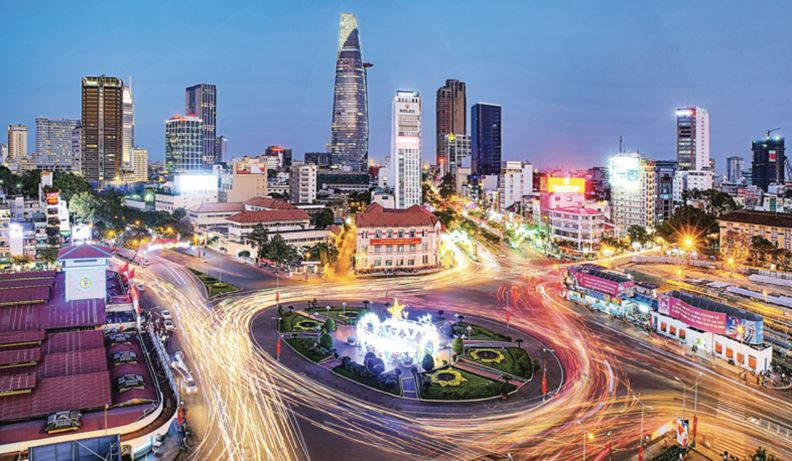Vietnam posted strong economic performance in the first half of 2025, with GDP growing 7.52 per cent compared to the same period last year. This was the highest first-half growth recorded in the 2011-2025 period, and signals a solid and resilient recovery despite the global headwinds. According to the National Statistics Office (NSO) at the Ministry of Finance, the economy has maintained its upwards momentum.
The path ahead, however, remains challenging. The mixed picture in the first half puts pressure on the government’s ambitious 8 per cent growth target for the second half, and demands continued policy support and private sector resilience to sustain the pace of growth.
Broad-based recovery
Vietnam’s record-breaking economic growth in the first half was driven by a robust and broad-based recovery across core economic regions. Industrial production and services remained the key pillars of expansion, with the industrial and construction sector growing 8.33 per cent and contributing 3.26 percentage points to GDP growth. Within this, manufacturing and processing continued to lead as the primary engine of economic momentum.
The services sector saw strong growth of 8.14 per cent, making the largest contribution to overall expansion, with 4.04 percentage points. Total retail sales of goods and consumer service revenue in the first half reached an estimated VND3,416.8 trillion ($131.41 billion), up 9.3 per cent year-on-year and an indicator of solid recovery in domestic demand.
Tourism also emerged as a standout performer. Vietnam welcomed nearly 10.7 million international visitors in the first half, a 20.7 per cent increase over the same period last year, underscoring the sector’s resurgence and Vietnam’s continued appeal.
Trade, meanwhile, delivered double-digit growth, with total import-export turnover estimated at $432.03 billion in the first half, up 16.1 per cent year-on-year. The country maintained a trade surplus of approximately $7.63 billion, bolstering macro-economic stability and foreign exchange reserves.
Foreign investment continued to reflect strong investor confidence. Total newly-registered foreign investment reached $21.52 billion, up 32.6 per cent year-on-year, while disbursed FDI hit a five-year high of $11.72 billion, rising 8.1 per cent. This demonstrates accelerating project implementation and expanding production capacity across sectors.
At the provincial level, the growth story was equally encouraging. In the first half of the year, prior to the consolidation of administrative units in Vietnam, ten provinces recorded growth rates above 10 per cent, laying a strong foundation for continued regional momentum in the months ahead.
Continuing hurdles
Alongside the encouraging results, Vietnam’s economy continued to face several ongoing challenges.
While the average Consumer Price Index (CPI) was kept at a reasonable level in the first half, rising 3.27 per cent year-on-year and highlighting the effectiveness of monetary policy management, global commodity price pressures remain a closely-watched risk.
According to Ms. Nguyen Thi Huong, Director General of the NSO, global inflation may still face significant pressure in the short and medium terms, even though it has eased from the peak levels of 2022-2023. “Commodity prices remain volatile, oil prices are trending upwards due to geopolitical instability and continued OPEC production cuts, shipping costs are rising amid ongoing conflicts, and food prices are likely to be affected by climate change,” she said. “Additionally, production costs are increasing as supply chains shift and localized production policies push manufacturing expenses higher. All of these factors may continue to fuel inflationary pressure going forward.”
Public investment, despite improving, with State capital investment in the first half rising 14.1 per cent year-on-year, still faces disbursement challenges. Accelerating public investment will remain a key task in the second half of the year to complete critical infrastructure and stimulate broader economic growth. However, such stimulus could also place upwards pressure on overall price levels.
While exports were a growth driver in the first half, the outlook for the second half remains clouded by risks, difficulties, and uncertainties. Industrial production, in particular, still faces issues requiring attention.
First, the mining sector continued its downwards trend from previous years, declining 3 per cent year-on-year in the first half. Within that, crude oil and natural gas extraction saw a sharp decline of 8.2 per cent, compared to a 12.4 per cent fall in the same period last year.
Second, though some manufacturing sectors continued to grow, the pace of expansion slowed in the second quarter of 2025. For example, the wood processing industry grew 16.2 per cent in the first quarter but slowed to 5.8 per cent in the second, while furniture manufacturing rose 12.6 per cent in the first quarter but moderated to 10.9 per cent in the second.
Third, inventory levels in the manufacturing sector remain relatively high. Specifically, the Index of Industrial Production (IIP) for the sector rose 11.1 per cent in the first half, but the consumption index for manufactured products rose only 9.8 per cent, or 1.3 percentage points lower year-on-year, leading to an increase in the inventory index of 12 per cent as of June 30, 2025. The average inventory-to-sales ratio in the first half reached 85.7 per cent; significantly higher than the 76.9 per cent posted in the same period of 2024.
In addition, while the real estate market has shown signs of thawing, further supportive policies will be needed to ensure a more sustainable recovery.
Room to grow
With GDP growth reaching 7.52 per cent in the first half of 2025, Vietnam’s economy has nearly met the updated growth target scenario set after the first quarter. This performance eases pressure on the remaining quarters of the year and provides a solid foundation for achieving the full-year growth goal.
However, this is a necessary condition for realizing the 8 per cent target. According to the NSO, Vietnam must fully leverage its remaining growth drivers in the second half to meet this ambitious goal.
Public investment is expected to serve as a critical engine of growth in the second half. The goal of disbursing 100 per cent of public investment capital would unlock significant growth potential, particularly through key national infrastructure projects, including expressways, airports, major urban Ring Roads, and energy infrastructure developments.
Science, technology, innovation, and digital transformation are also seen as strategic growth drivers. The surge in technological advancement and digital innovation is expected to open up opportunities for enterprises to integrate and apply AI in production processes, helping reduce costs, improve productivity, and enhance competitiveness.
With the credit growth target set at 16 per cent, subject to adjustments in line with real-time economic developments, the availability of capital is anticipated to significantly boost economic activity by fueling business operations, investment, and consumer demand.
Consumer spending is also being supported by a 2 per cent VAT reduction policy effective from July 1, 2025, applied to various goods, along with domestic demand stimulation policies. Additionally, support measures under Government Decree No. 178/2024/ND-CP on support policies for officials and public employees are expected to promote consumption, investment, and asset accumulation, further reinforcing economic expansion.
With these drivers in play, the NSO’s updated 2025 growth scenario projects first-half GDP growth of 7.52 per cent, second-half growth of 8.42 per cent, and full-year growth of 8 per cent. This includes quarterly growth estimates of 7.05 per cent in the first quarter, 7.96 per cent in the second quarter, 8.33 per cent in the third quarter, and 8.51 per cent in the fourth quarter.
Strategic outlook
According to international organizations, the global economy is likely to follow a “slow but steady” upwards trajectory, characterized by modest growth, persistently high inflation, cautious monetary policy, and ongoing risks in global trade and finance that could disrupt recovery momentum. However, the third quarter of this year will be a pivotal period for production growth, as businesses ramp up to meet rising consumption demand ahead of major holiday seasons in the US and Europe.
Domestically, the ongoing restructuring of the two-tier local government model, streamlining intermediate layers and reducing administrative procedures, is expected to enhance the business environment, enabling enterprises to plan and operate more proactively.
Efforts to clamp down on counterfeit and substandard goods have intensified, motivating businesses to step up legitimate production. At the same time, accelerated progress in public investment projects and the growing influx of FDI into the real estate sector are set to drive demand in construction-related industries, such as cement, concrete, and steel, contributing to sustained growth in industrial production.
Despite these favorable developments, global uncertainties persist, and external market demand has yet to rebound strongly. To achieve its growth targets, Vietnam must implement a coordinated and decisive set of priority measures.
First and foremost, maintaining macro-economic stability is the foundation of all efforts. This involves managing monetary policy flexibly, keeping inflation under control, and stabilizing exchange rates to reinforce confidence among investors and the public. On that basis, Vietnam must resolutely accelerate public investment disbursement, viewing it as a top political priority to drive infrastructure development and stimulate broader economic growth.
In parallel, the country must fully leverage the advantages of its free trade agreements (FTAs) to boost exports, while meaningfully improving the investment climate to attract high-quality FDI aligned with long-term development goals.
In addition to external drivers, strengthening domestic consumption and expanding the internal market are equally critical, particularly by tapping into the recovering tourism and services sectors. Sustainably enhancing competitiveness will require a strategic, cross-sectoral focus on science, technology, innovation, and digital transformation.
Ultimately, Vietnam must continuously improve its capacity to adapt, proactively analyze and forecast global economic trends, and build responsive policy scenarios. Doing so will help mitigate risks and ensure stable, long-term development amid an increasingly complex global landscape.









 Google translate
Google translate